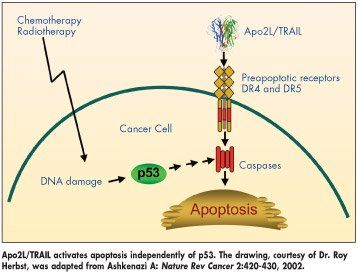'Death Receptors' Are New Targets for Cancer Treatment
A new bioengineered protein that targets two apoptosis receptors produced one dramatic tumor regression and stopped tumor growth in several cases of disease stabilization in 60% of the advanced cancer patients treated in a phase I dose-finding trial
ATLANTAA new bioengineered protein that targets two apoptosis receptors produced one dramatic tumor regression and stopped tumor growth in several cases of disease stabilization in 60% of the advanced cancer patients treated in a phase I dose-finding trial, according to Roy S. Herbst, MD, PhD, of M.D. Anderson Cancer Center. Dr. Herbst reported the phase I trial of Apo2L/TRAIL (Apo2L) at the American Society of Clinical Oncology 42nd Annual Meeting (abstract 3013).
"Although these are early data, this new class of agents targeting receptor pathways that promote cell death is showing itself to be safe and may have activity in patients with advanced cancer, potentially giving us a new weapon to combine with other targeted agents in the treatment of this disease," Dr. Herbst said.
Apo2L is the only dual proapoptotic receptor agonist that directly activates both proapoptotic receptors (DR4 and DR5). Apo2L selectively induces apoptosis (programmed cell death) in a variety of cancer cells, while sparing most normal cells in preclinical models, he said (see Figure).

This was the first clinical trial to evaluate Apo2L. Fifty-one patients are enrolled, all with advanced solid tumors or non-Hodgkin's lymphoma (NHL). They were treated with Apo2L for 5 consecutive days every 3 weeks for up to eight cycles. Dose levels were 0.5, 1.5, 4.0, 8.0, and 15.0 mg/kg. Patients without liver metastasis were treated before patients with liver metastasis in a staggered fashion.
Dr. Herbst reported data for 36 of 51 patients. The most common diagnoses were colorectal cancer, melanoma, lung cancer, and ovarian cancer. "After 586 administered doses, there were no dose-limiting toxicities or clearly attributable toxicities," he said.
The researchers have completed at least one post-baseline tumor assessment in 37 patients: 22 (60%) have stable disease after four cycles of treatment, and 4 (10%) have stable disease after eight cycles. One patient with chondrosarcoma had a confirmed partial response at the 8 mg/kg dose level. No anti-Apo2L antibodies have been detected.
The main side effects were mild to moderate, most commonly diarrhea and fatigue. Unlike apoptosis-inducing agents that target other receptors, there were no significant side effects caused by Apo2L even in patients with preexisting liver problems. No patients had drug-related dose-limiting toxicity. Two patients with sarcomas had serious side effects linked to tumor necrosis. "Some patients with disease progression experienced liver-related serious adverse events. Investigators believe that these events were not related to the drug," Dr. Herbst said.
He concluded that Apo2L is safe and well tolerated up to 15 mg/kg. Enrollment in the study is continuing and the investigators will continue to escalate the dose to 20 mg and 30 mg.